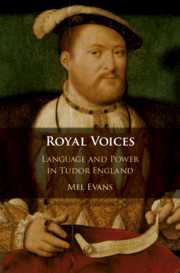Book contents
- Royal Voices
- Royal Voices
- Copyright page
- Dedication
- Contents
- Figures
- Tables
- Acknowledgements
- Introduction
- Part I Authentic Royal Voices
- Part II Appropriated Royal Voices
- 5 Non-Royal Views of Royal Voices
- 6 Impostor, Protector and Queen
- 7 Writing Royal Voices
- 8 Royal Voices, Narrative and Ideology in Sixteenth-Century Chronicles
- Conclusion
- Works Cited
- Index
8 - Royal Voices, Narrative and Ideology in Sixteenth-Century Chronicles
from Part II - Appropriated Royal Voices
Published online by Cambridge University Press: 28 February 2020
- Royal Voices
- Royal Voices
- Copyright page
- Dedication
- Contents
- Figures
- Tables
- Acknowledgements
- Introduction
- Part I Authentic Royal Voices
- Part II Appropriated Royal Voices
- 5 Non-Royal Views of Royal Voices
- 6 Impostor, Protector and Queen
- 7 Writing Royal Voices
- 8 Royal Voices, Narrative and Ideology in Sixteenth-Century Chronicles
- Conclusion
- Works Cited
- Index
Summary
The final analytic chapter looks at royal reported discourse in historical chronicles: printed texts intended for a large, public audience. Focussing on three chronicles' accounts of the reign of Henry VII, the study finds that rhetorical principles inform the depiction of royal voices in the texts. In general, there is no clear distinction made between royal and non-royal reports, with discourse representation more obviously driven by narrative concerns e.g. narrative peaking. However, two lengthy orations of Richard III and Henry VII, found in Grafton's chronicle, are considered in detail. The formulaic characteristics of Tudor royal texts are most evident in Richard III's oratory, whereas Henry VII has a less institutionalised rhetoric. The findings point to the accepted creativity of discourse representation in historiography in the period, and the salience of key features of the royal voice when undertaking this creative work.
Keywords
- Type
- Chapter
- Information
- Royal VoicesLanguage and Power in Tudor England, pp. 215 - 234Publisher: Cambridge University PressPrint publication year: 2020

